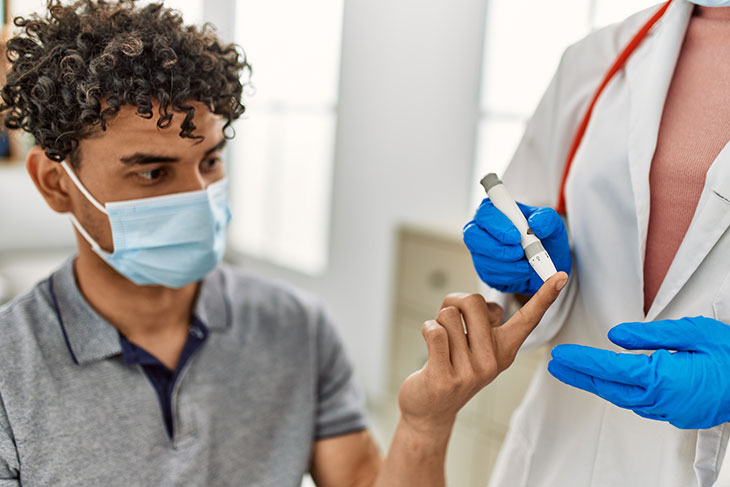
Diabetes is a chronic health condition that affects more than 37 million people in the U.S., according to the Centers for Disease Control and Prevention (CDC). About 1 in 5 Americans with diabetes don't know they have it.
The good news for people with diabetes is that you can learn how to decrease complications and live a long, healthy life. It's also important for all of us to know our risk factors for diabetes and how to reduce the chance of getting diabetes.
What is diabetes?
Diabetes is a condition where your body has challenges regulating the sugars, or glucose, in the blood. It's natural to have sugar in your bloodstream since it provides your body with energy.
When you eat, your body breaks down the food and converts some of it into sugar. The sugar then enters the blood stream. When this happens, a hormone called insulin is released to help move the sugars into the cells. That sugar is then converted into energy.
Your pancreas makes insulin. It knows how much to make and when to release insulin to the rest of your body. When a person has diabetes, the sugars build up in the bloodstream because it has trouble getting into the cells. High sugars in the body's blood vessels can cause damage to organs like the heart, eyes, kidneys, and other parts of your body.
Learn about insulin resistance and how we can help
Types and causes of diabetes
There are three main types of diabetes, and the causes are different for each.
Type 1 diabetes
Type 1 diabetes tends to occur suddenly. Type 1 diabetes is an auto-immune condition where the body attacks the pancreas. The pancreas is then unable to make insulin. Without insulin, the sugar cannot enter the cells. Treatment for type 1 diabetes is to take daily insulin injections.
Type 2 diabetes
Type 2 diabetes is the most common type of diabetes and is a condition that occurs slowly. With this type of diabetes your body's cells have trouble using insulin properly over a period of time. This is known as insulin resistance. The pancreas then over-produces insulin to help the sugar get into the cell. This causes the pancreas to tire out, leading to less insulin production over time.
Luckily, with annual doctor visits to check your blood work, you can catch these symptoms early. This can decrease your chances of getting type 2 diabetes.
Read about healthy habits to help you prevent or manage your type 2 diabetes
Gestational diabetes
Gestational diabetes is a condition that affects pregnant women. The body is unable to regulate the blood sugars during pregnancy. Typically, the body resumes normal blood sugar regulation after the baby is born. If a woman has had gestational diabetes, she should be monitored regularly for signs of type 2 diabetes.
View the diabetes and endocrinology services we offer
Symptoms of diabetes
Some common first signs of diabetes are:
- frequent urination
- thirst
- blurry vision
- tiredness
- extreme hunger
- itchy skin
- infections that take longer to heal
- sudden weight loss without trying
If you're experiencing any of these symptoms, consider calling your primary care physician for a checkup.
Find out why you should partner with a primary care provider for your health
Can you get rid of diabetes?
Type 1 and type 2 diabetes are not reversible. They are manageable, and you can live a long healthy life with diabetes. Gestational diabetes typically only occurs during pregnancy, and the body resumes normal function after the baby is born.
See the prediabetes risk factors and why most don't know they have it
Diabetes risk factors
According to the CDC, known risk factors for type 1 diabetes include:
- Family history: Your risk for type 1 diabetes increases if you have a parent or sibling with type 1 diabetes.
- Age: Type 1 diabetes can happen at any age, but it usually starts showing in children, teens, and young adults.
There are several risk factors that can increase your chance of type 2 diabetes:
- You have prediabetes.
- You are overweight.
- You have a parent or sibling with type 2 diabetes.
- You are not physically active.
- You have had gestational diabetes or have given birth to a baby who weighed more than 9 pounds.
- You are an African American, Hispanic or Latino, American Indian, or Alaska Native person. Some Pacific Islanders and Asian Americans are also at higher risk, according to the CDC.
You can take a short quiz to assess your risk of type 2 diabetes from the American Diabetes Association.
Get help managing your diabetes
UC Davis Health offers free diabetes classes. You can see the variety of classes we offer online and in person.
To sign up for these classes, call 916-734-0718 or enroll on the MyUCDavisHealth app or website. (On your smartphone app or desktop, click on "Visits" at the top and then "Schedule an Appointment." Scroll down and click on "Health and Wellness Classes." From there, follow the prompts to sign up for the class you want.)
Learn about our world-class diabetes care
This blog was written by Melinda Gong, a registered dietitian at UC Davis Health.




